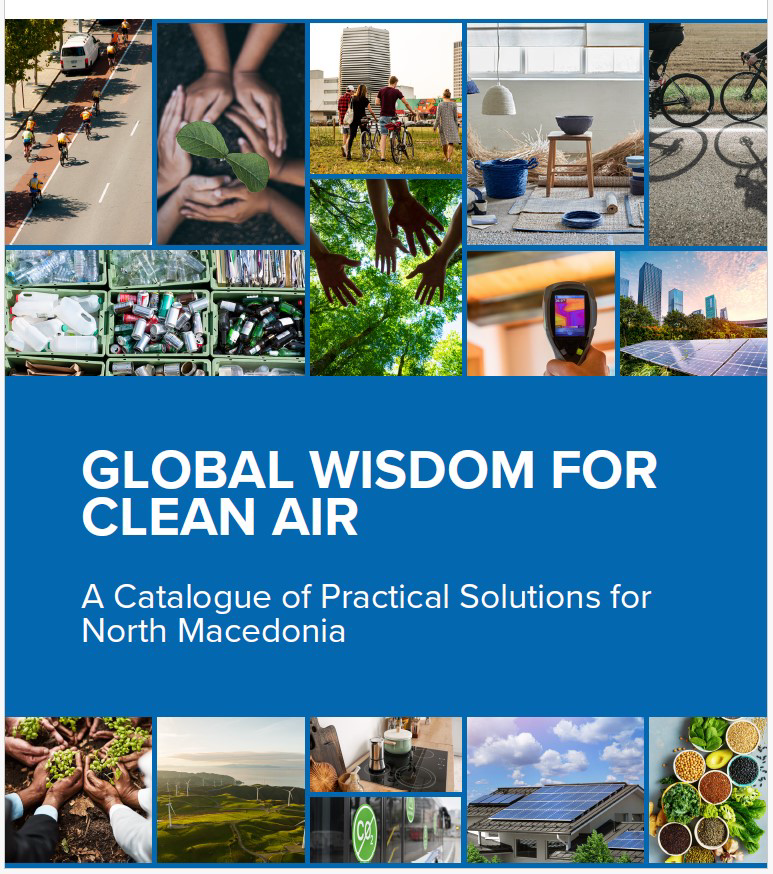Disclaimer:
Please be aware that the content herein has not been peer reviewed. It consists of personal reflections, insights, and learnings of the contributor(s). It may not be exhaustive, nor does it aim to be authoritative knowledge.
Learnings on your challenge
What are the top key insights you generated about your learning challenge during this Action Learning Plan? (Please list a maximum of 5 key insights)
Open Data as a Catalyst for Change: Leveraging open data not only provides transparency but also fosters collaborative innovation. It enables stakeholders, including governments, NGOs, and citizens, to co-create solutions for air pollution.
Scalable Solutions Require Local Context: While technology and data provide universal tools, their effective application requires tailoring solutions to local contexts, such as understanding specific pollution sources in North Macedonia.
Multi-Stakeholder Collaboration is Essential: Addressing complex challenges like air pollution requires partnerships across sectors, including public, private, and academic institutions, to integrate diverse expertise and resources.
Data Visualization Enhances Public Engagement: Clear and accessible data visualizations empower citizens by making air quality data comprehensible, encouraging community-driven actions and policy advocacy.
Iterative Learning Drives Progress: Implementing data-driven interventions requires a cycle of action, reflection, and adaptation. Regular feedback loops help refine solutions and improve their scalability.
Considering the outcomes of this learning challenge, which of the following best describe the handover process? (Please select all that apply)
Our work has led to significant changes in our UNDP Country Office programming, Our work has been picked up by UNDP or the government and has now expanded geographically in our country
Can you provide more detail on your handover process?
The handover process was designed to ensure continuity and scalability of the work on scaling solutions to air pollution. Key elements included:
Knowledge Sharing with the Project Team:
Regular meetings and workshops with the team to align on objectives, methodologies, and tools used in leveraging open data.
A detailed handover document outlining the process, challenges, and lessons learned during the project, including insights on data sourcing, cleaning, and visualization techniques.
Documentation of Processes and Tools:
Creating step-by-step guides for replicating the data collection, processing, and visualization workflow, ensuring that the team could independently manage and enhance these processes.
Archiving all datasets, code, and project-related materials in a shared repository for easy access and reuse.
Capacity Building and Skill Transfer:
Conducting training sessions for the project team on the use of open data platforms, visualization tools, and methods for engaging stakeholders using data insights.
Establishing a knowledge-sharing protocol to ensure future team members could easily onboard into the project.
Stakeholder Engagement Plan:
Collaborating with the team to create a roadmap for ongoing stakeholder engagement, emphasizing the importance of continuous data sharing with government bodies, NGOs, and the public.
Providing templates for stakeholder reports and public communication materials to maintain transparency and build trust.
Sustainability and Scalability Recommendations:
Advising the team on strategies to scale the project nationally, including integrating more diverse datasets and building partnerships with additional local governments and organizations.
Identifying potential funding sources and opportunities to expand the initiative beyond the current scope.
Please paste any link(s) to blog(s) or publication(s) that articulate the learnings on your frontier challenge.
Data and Methods
Relating to your types of data, why did you chose these? What gaps in available data were these addressing?
The types of data chosen for this initiative were carefully selected to address critical gaps in understanding air pollution and to align with the principles of transparency, accessibility, and scalability.
Data Generation through Research:
The dataset was built using a rigorous research methodology to ensure its relevance and accuracy. We analyzed existing literature, studies, and public records to identify key indicators of air pollution and their sources. This allowed us to create a dataset that filled the gap in localized, actionable information about air quality and its contributors.
Engagement with UN Volunteers (UNVs):
A unique aspect of this project was the development of methods to engage UNVs in data collection and validation. UNVs played a crucial role in sourcing and curating open data, applying a consistent methodology to ensure quality. This approach not only enriched the dataset but also empowered local communities to contribute directly to the initiative.
Utilizing Open Data Sources:
The dataset was generated entirely using open information available online. This approach ensured transparency and replicability, enabling other regions or teams to adopt similar methodologies. Every piece of information was carefully referenced, ensuring credibility and traceability.
Addressing Data Gaps:
Lack of Granular and Localized Data: Existing datasets often lacked detail specific to North Macedonia, such as hyperlocal pollution sources or seasonal trends. By curating open data and involving local stakeholders, we bridged this gap.
Insufficient Publicly Available Datasets: Many datasets were fragmented or locked behind paywalls. By using open information, we demonstrated that impactful solutions could be built without relying on proprietary data.
Engagement-Driven Insights: Traditional datasets often missed community-level insights, such as behavioral patterns contributing to pollution. Engaging UNVs added depth to the data by integrating these perspectives.
Why was it necessary to apply the above innovation method on your frontier challenge? How did these help you to unpack the system?
The complex and multifaceted nature of air pollution as a frontier challenge required the application of innovative methods to uncover root causes, identify leverage points, and design actionable solutions. Here's how these methods proved essential and effective:
Human-Centered Design (HCD):
Why Necessary: Air pollution impacts diverse groups differently, and existing interventions often lacked alignment with community needs.
Impact: HCD ensured that the voices of those directly affected—residents, local authorities, and community organizations—were integrated into the solution design. This participatory approach revealed localized behaviors (e.g., reliance on wood-burning stoves) and perceptions that were not immediately evident in existing data.
Open Data Utilization and Crowdsourcing:
Why Necessary: Publicly available data on air quality was often fragmented, outdated, or inaccessible, leaving critical gaps in understanding pollution patterns.
Impact: By leveraging open data and crowdsourcing efforts with UNVs, the project created a comprehensive dataset that illuminated pollution hotspots and seasonal trends. This method also revealed systemic issues such as inconsistent data sharing practices and limited public awareness of pollution levels.
Rapid Prototyping and Testing:
Why Necessary: Traditional policy and intervention design processes are often slow and disconnected from ground realities. Rapid iteration was needed to create timely and practical solutions.
Systems Thinking:
Why Necessary: Air pollution is a symptom of interconnected systems, including urban planning, transportation, industrial practices, and individual behaviors. Addressing it required a holistic approach.
Impact: Systems mapping helped identify key leverage points, such as addressing traffic congestion during peak hours or advocating for cleaner industrial practices. It also highlighted policy gaps, such as the lack of enforcement for emissions standards.
Collaborative Capacity Building:
Why Necessary: Sustainable solutions require empowered local actors who can continue scaling and maintaining initiatives beyond the project timeline.
Impact: Engaging and training UNVs created a network of local champions who could independently collect, analyze, and share data. This capacity-building approach also unveiled systemic barriers, such as limited technical expertise and resources in local institutions.
Unpacking the System:
These methods collectively enabled the project to move beyond surface-level observations and delve into the underlying dynamics of air pollution. By combining data-driven insights with human-centered perspectives, we were able to identify not only the symptoms but also the structural and behavioral drivers of the problem, paving the way for more effective, scalable, and sustainable interventions.
Partners
Please indicate what partners you have actually worked with for this learning challenge.
Please state the name of the partner:
UNV
What sector does your partner belong to?
United Nations
Please provide a brief description of the partnership.
We partnered with UNV to leverage the skills and dedication of online volunteers, creating a dynamic and collaborative environment. These volunteers were integral to the data collection, analysis, and visualization process, contributing their expertise to curate and validate open data.
Throughout the project, we engaged multiple teams, including:
Data Collection and Research Team: Focused on sourcing and validating open data.
Visualization and Communication Team: Designed user-friendly catalogue and visual tools to make insights accessible.
Is this a new and unusual partner for UNDP?
Yes
End
Bonus question: How did the interplay of innovation methods, new forms of data and unusual partners enable you to learn & generate insights, that otherwise you would have not been able to achieve?
The combination of innovative methods, open data, and partnerships with UNV online volunteers created a unique synergy that unlocked insights unattainable through traditional approaches.
Innovation Methods Driving Depth of Learning:
Human-Centered Design ensured that community perspectives directly shaped solutions, uncovering localized pollution sources (e.g., seasonal practices) that were often overlooked in existing datasets.
Systems Thinking provided a comprehensive view of air pollution as part of a complex ecosystem, enabling the identification of interconnected factors such as urban traffic patterns and industrial emissions.
Open Data Filling Critical Knowledge Gaps:
By leveraging publicly available data, the project addressed gaps in localized and real-time air quality information.
Crowdsourcing data with UNVs ensured that the dataset was comprehensive, credible, and representative of diverse sources, creating a baseline for understanding pollution dynamics.
Unusual Partners Sparking Collaborative Innovation:
Partnering with UNVs brought in a diverse range of skills and perspectives from volunteers worldwide, enriching the project with fresh ideas and technical expertise.
The decentralized approach of engaging online volunteers facilitated data curation at scale, while also fostering a sense of global ownership in tackling air pollution.
Insights Unlocked Through Synergy:
Behavioral Patterns and Community Insights: UNVs contributed ground-level observations and local knowledge, revealing behavioral practices (e.g., reliance on traditional heating methods) that directly impacted pollution levels.
Scalable Data-Driven Solutions: The use of open data and rapid prototyping allowed for iterative testing and refinement of visualizations, making them more user-centric and impactful.
Holistic Understanding of the System: The intersection of diverse methods and partnerships enabled a nuanced understanding of air pollution's systemic nature, highlighting leverage points like policy advocacy for stricter emissions standards and increased public awareness campaigns.
Please upload any further supporting evidence / documents / data you have produced on your frontier challenge that showcase your learnings.


 3
3
 11Sustainable cities and communities
11Sustainable cities and communities 13Climate action
13Climate action
Comments
Log in to add a comment or reply.